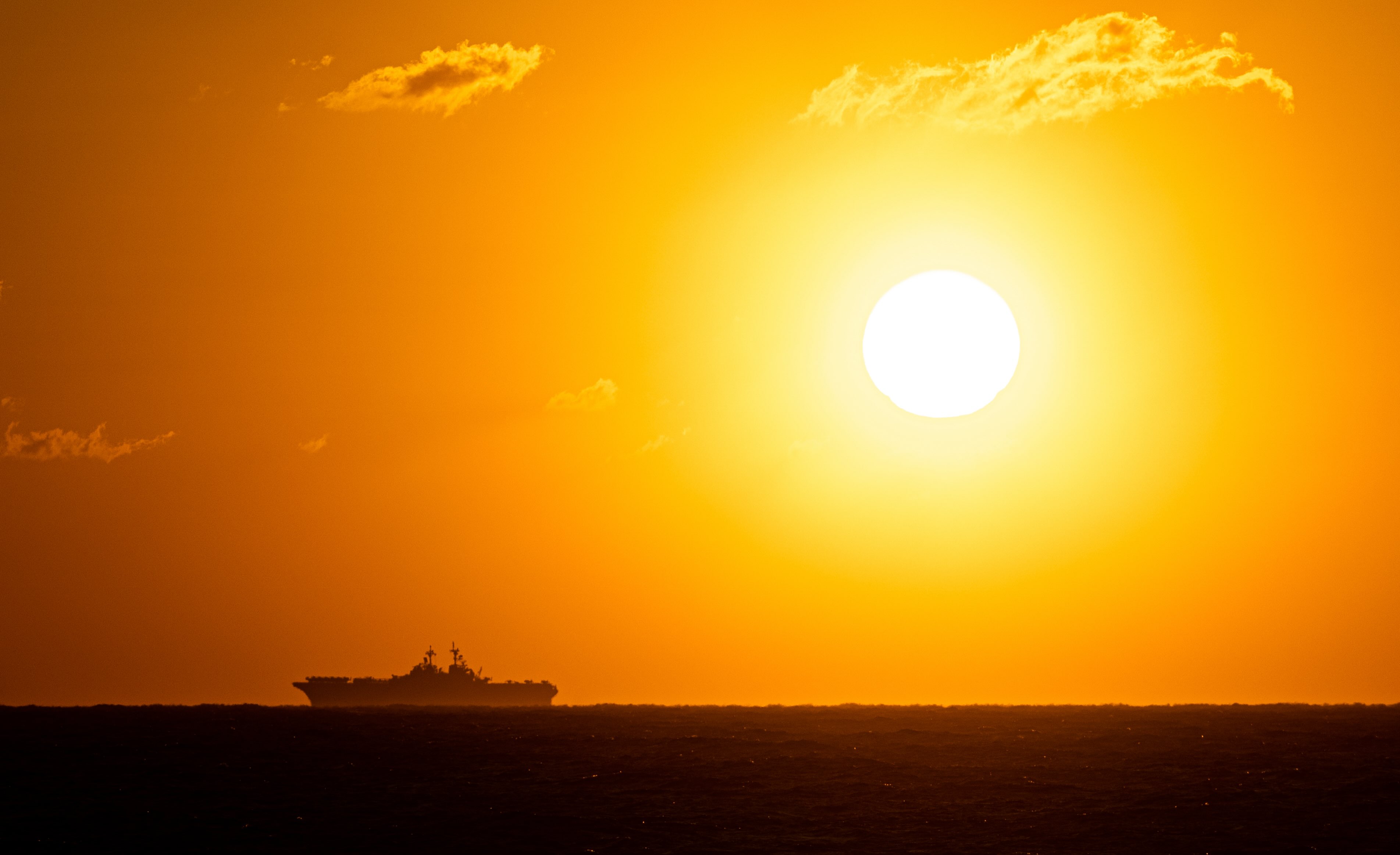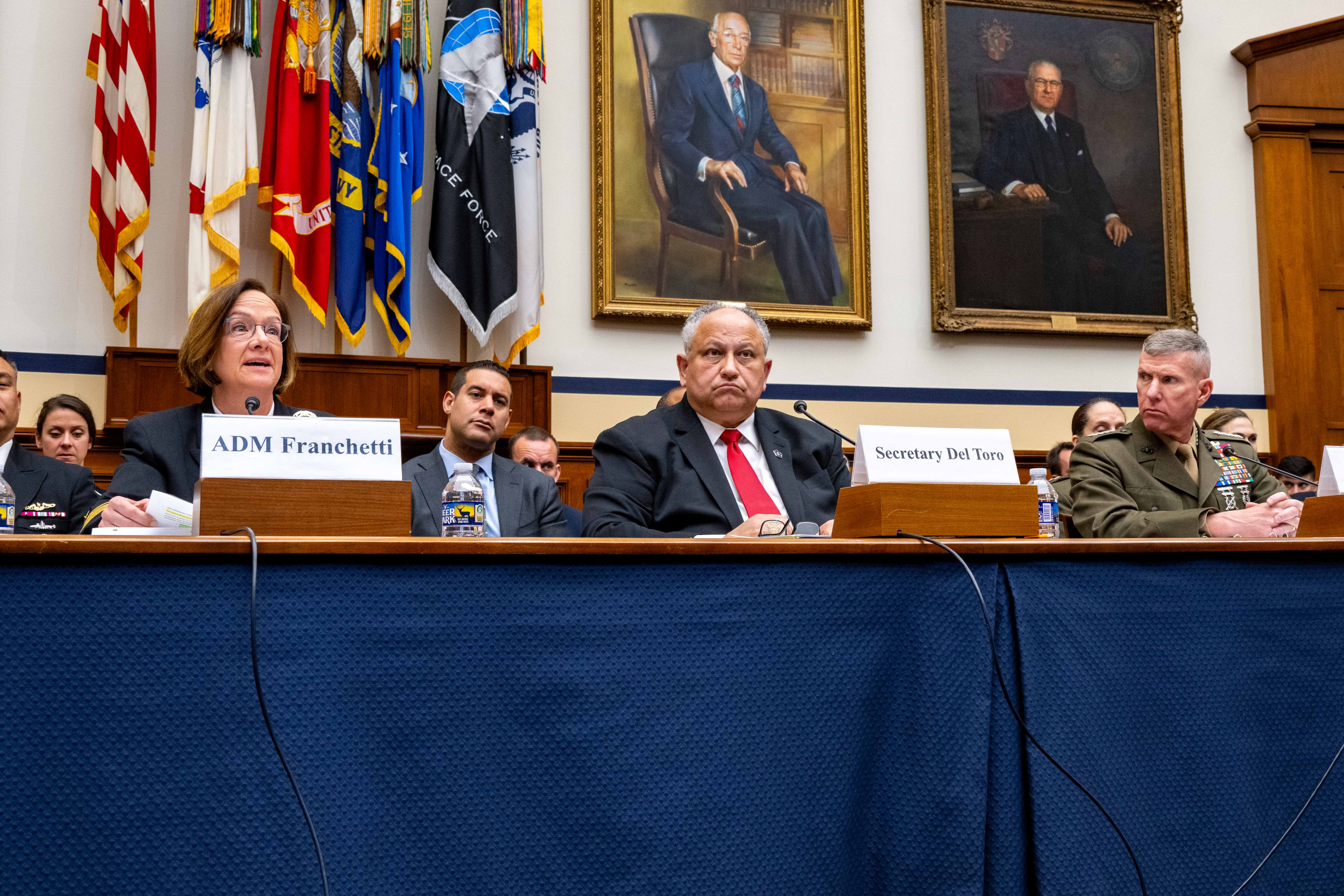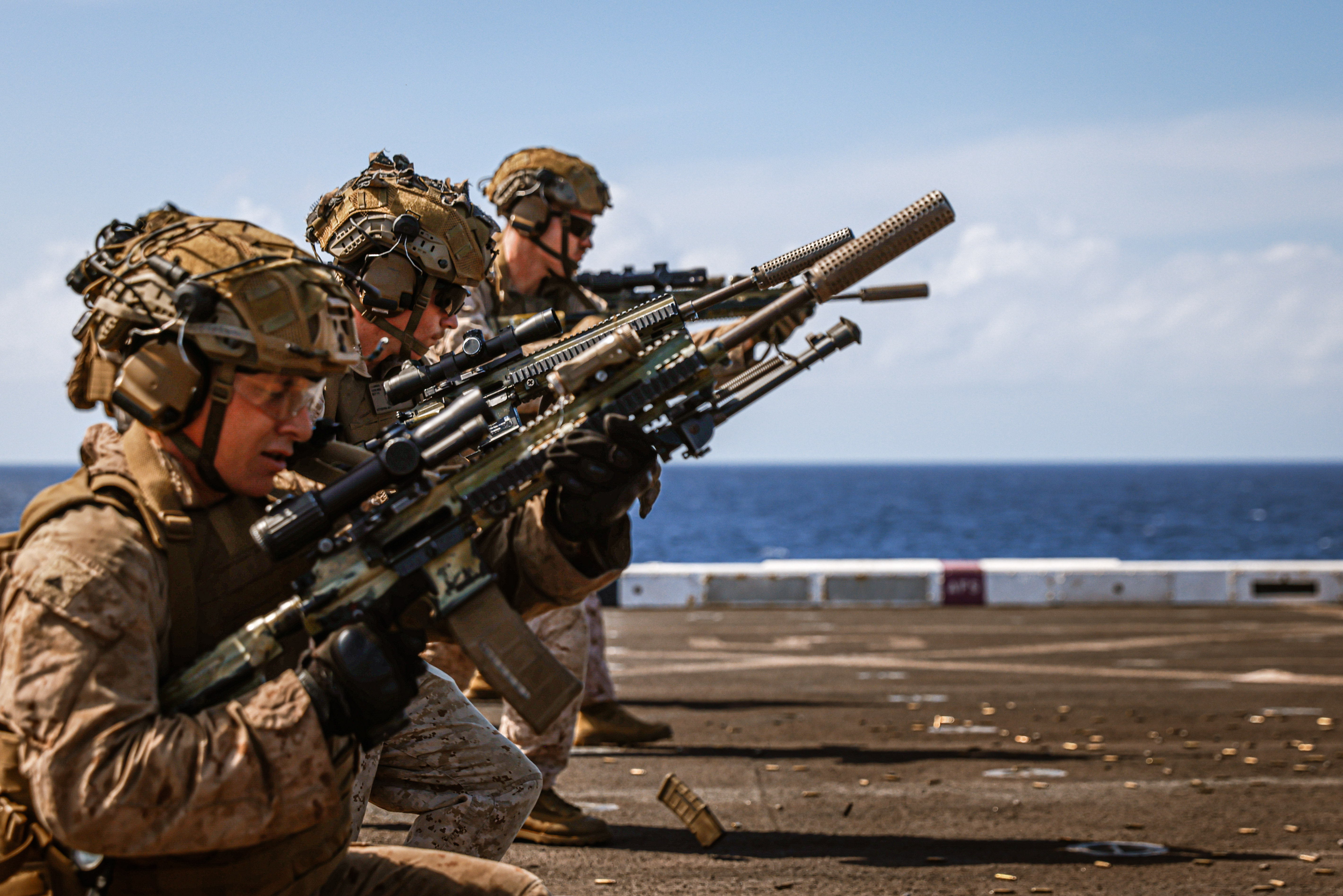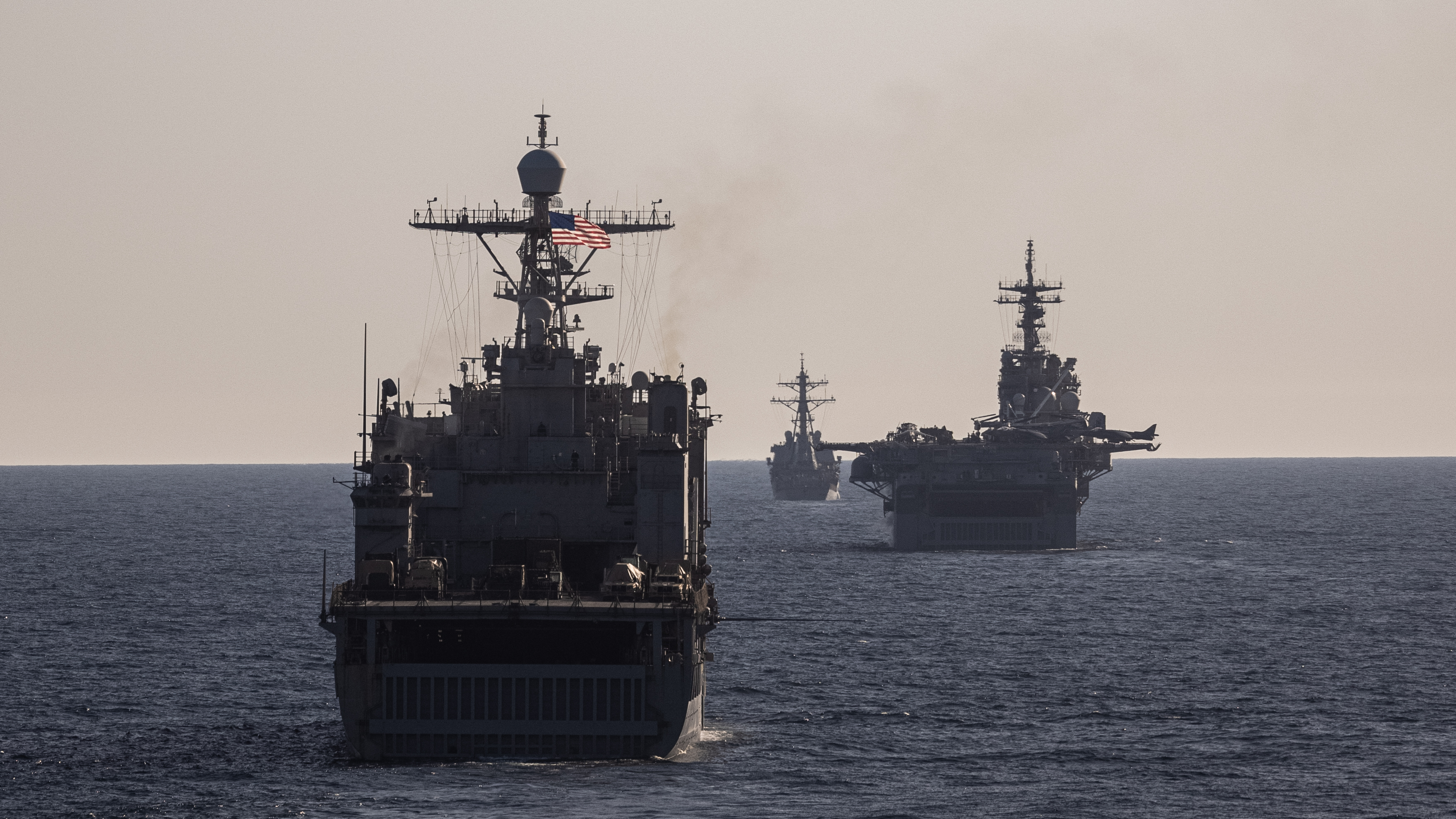
WASHINGTON, D.C. – While the long-term future for the amphibious fleet is secured with a Navy commitment to 31 amphibious warships in the Fiscal Year 2025 budget, the short-term problem of getting Marines to sea is less settled.
Maintenance issues with the Navy’s aging Wasp-class big-deck amphibious warships and Whidbey Island-class dock landing ships have abbreviated Marine Expeditionary Unit deployments, forcing the Navy and Marine Corps to cobble together less-than-ideal solutions to get MEUs to sea, officials from both services said this week.
To that end, the Navy and Marine Corps are nearing an agreement that would uniformly define amphibious ship readiness requirements, as the services face maintenance challenges that have led to delayed deployments.
The CNO and Commandant agree that the services must work toward a goal of 80 percent readiness for the fleet of 31 L-class ships, which should include 21 amphibious transport docks and 10 big-deck amphibious assault ships, Smith said Thursday at the annual Modern Day Marine symposium in Washington, D.C.
“We have a long way to go to get there. We put off maintenance,” Smith told the audience, noting that it’s the combatant commanders who ask to extend the deployments of Amphibious Ready Groups due to operational requirements, not the Navy.
“We have to get back to a three to make one readiness rate, where we have three ARG/[Marine Expeditionary Units] with the full up round ships. We’ve got the Marines. We just need the ships,” Smith said.
Following recent guidance from Chief of Naval Operations Adm. Lisa Franchetti and Marine Corps Commandant Gen. Eric Smith, officials have been working on common “terms of reference” to describe the state of readiness for the amphibs. The goal is to create a memorandum of understanding between the two services to put a lasting agreement in writing.
In the last several months, amphibious warships have experienced significant maintenance delays and technical problems, leading to delayed deployments and requiring the services to retool exercise plans.

After problems in its engineering department last year, USS Boxer (LHD-4) left nearly three months late for a deployment to the Indo-Pacific in early April, only to turn around fewer than two weeks later due to a faulty starboard rudder and bearing. The ship is now pier side at Naval Base San Diego, Calif., awaiting underwater repairs from divers due to the lack of dry dock capacity. The repairs could take two months, meaning Boxer might not deploy again until six months after the first ship in the ARG left.
The ongoing maintenance woes led to a split deployment for the ARG – USS Somerset (LPD-25) left in January, while USS Harpers Ferry (LSD-49) deployed in mid-March – and prevented Boxer from participating in the annual Balikatan exercise with the Philippines.
At the conference on Thursday, multiple Marine Corps generals cited the amphibious readiness challenges, the aging fleet and the ongoing work on the memorandum of understanding.
“The obvious 800-pound gorilla in the room is the state of the amphibs,” Lt Gen. Karsten Heckl, the deputy commandant for combat development and integration, said during a panel.
“We have over 20 years of operations in the Middle East and [U.S. Central Command],” he added. “We’ve ground our forces up pretty good, right. We flew the paint off our aircraft. We drove the paint off the bottom of the hulls of the ships. I mean, we just kept going without really due regard of what needed to be done and now we’re paying for it. And we’re trying to do it again … in a particularly difficult fiscal environment, which is never easy.”
Heckl said Secretary of the Navy Carlos Del Toro supports the three-ship ARG construct, a hallmark of Marine Corps doctrine for decades.
“At a minimum we need nine amphibious ships that are sort of ready to go at any given time, three overseas, three on each coast, to be able to fulfill whatever ARG/MEU mission develops around the world,” Del Toro told reporters on Thursday.
Amid the maintenance challenges with the Boxer ARG earlier this year, language circulated in the Pentagon referring to any formation with fewer than three amphibious ships as an “amphibious task force.” Marine Corps officials have repeatedly maintained that an ARG must include three L-class ships.

In a March interview, Heckl told USNI News that the preference for a MEU deployment is a three-ship ARG, but it’s been difficult.
“An ARG has to be three ships – amphibious warships – not two amphibious warships and an ESB, not one amphibious warship and an LCS and a T-EPF. That’s not an ARG. For a MEU to be properly employed requires a minimum of three amphibious warships,” Heckl told USNI News at the time.
In the interview, Heckl said Marine Corps modeling projects that in 2026, there could potentially be a more than half-a-year gap in ARG/MEU presence.
Smith referenced the gaps on Thursday and argued the Navy and Marine Corps need to achieve the 80 percent readiness goal with 31 amphibious ships to maintain the two patrols by the forward-deployed amphibious presence out of Japan and consistent three-ship ARG/MEU deployments from both the east and west coasts.
“We’re looking at three, four-month gaps, maybe six-month gaps in ARG/MEU presence,” Smith told reporters.
Several Marine Corps generals said the current mix of L-class ships is not the right one, stressed that the services need newer ships and praised the Navy’s latest Fiscal Year 2025 budget outlook for buying four amphibs – one big-deck and three amphibious transport docks – in the next five years.
“Our amphib readiness is not in a good place right now. The Navy knows it. We know it, which is another reason we’re trying to build new because you can keep putting money into old, but it’s just like putting money into your 1974 Audi,” Smith added “I mean, you can keep putting money into it and you can find a mechanic to fix it, but at some point, you’re searching all over hell’s half acre for the parts for a 1974 Audi. And you need to buy a new Audi. And that’s why we’re buying new.”
Last year, Marine Corps officials voiced frustration over the lack of ready amphibious ships to respond to a deadly earthquake in Turkey and an evacuation in Sudan due to the ongoing civil war. Heckl told reporters Thursday that he’s still concerned something like this could happen again due to the poor state of the amphib fleet.
“A crisis response force is by its nature, must be timely. To be timely for Marines, we have to be employed, we have to be deployed on amphibs, forward-deployed,” Heckl said.
“There’s a long list of examples where we have responded in a very timely manner from amphibs. Right now we know that there are going to be very, very significant gaps where we will not have out a West Coast and an East Coast MEU at the same time,” he added.
As for the memorandum of understanding, the team working on the agreement includes the staffs of the Marine Corps deputy commandant for plans, policies and operations, the Navy’s deputy chief of naval operations for operations, plans and policy, U.S. Fleet Forces, and the Marine Corps deputy commandant for combat development and integration.
After recently convening the three stars, the services will have their work culminate in a briefing to Franchetti and Smith in mid-May, Lt. Gen. James Bierman, the deputy commandant for plans, policies and operations, told reporters Thursday.

“We’re going to take a centralized aligned look at how we’re deploying the MEUs to make sure – ARG/MEUs – to make sure we’re spreading that capability out as much as possible as we work through maintenance challenges,” he said of the MOU during a panel.
Bierman, who previously commanded III Marine Expeditionary Force in Okinawa, Japan, said the ongoing work on the common definition has featured “a lot of back and forth” between the services, but it’s been healthy.
“As we fight our way through a period of low amphib readiness, how do we best I’ll say spread the peanut butter, use the available ships, ARGs and MEUS we have, to get as much smart strategic coverage as we can get,” Bierman told reporters.
Maj. Gen. Marcus Annibale, the director of expeditionary warfare on the chief of naval operations’ staff (OPNAV N95), said the surface community is using modeling and data and looking at spare parts like the naval aviation community did to improve amphibious ship readiness.
“What’s a partial mission capable, full mission capable, non-mission capable [amphib], what does that all mean and making sure our terminology is straight,” Annibale said.





